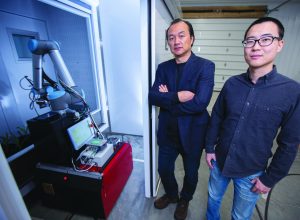
“We combine intelligent robotics and sensing technologies to improve both the throughput and the quality of plant measurements, a core need in the growing fi eld of predictive plant phenomics,” said Tang, an associate professor of agricultural and biosystems engineering.
In plant sciences, genomic and environmental data is already abundant and reliable. Tang’s autonomous robotic plant measurement systems supply the missing piece needed to understand the relationships between genes, growing environment and plant traits – and ultimately accurately predict how to improve crop plant yield and resilience.
Tang’s robots enable better data-driven plant science from the lab to the field.
Enviratron
Tang is a co-principal investigator in a campus wide project to create the Enviratron, an autonomous robot that measures plant growth in highly-controlled laboratory plant growth chambers. “We installed the best sensing technologies available on a robot with an arm that reaches out and gets very close to the plants, as close as previously-used handheld measurement devices can,” said Tang. “Enviratron is able to duplicate and improve on the measurements that required a lot of human labor.”
The Enviratron robot rover automatically moves from growing chamber to chamber, using a 3-D camera, a hyperspectral sensor, a fluorescence detector and a Raman scattering spectrometer to measure plants under different environmental conditions. Keeping plants in their growth chambers for measurements ensures fewer outside variables are introduced – and improves data quality.
This National Science Foundation-funded project has shown some major advantages over previous plant growth and measurement techniques, opening new possibilities in plant sciences research.
Phenobots
Tang’s plant-measuring robotics extends beyond the lab to the fi eld with his Phenobots. Like the Enviratron, these fi eld-based phenotyping robots carry measurement sensors, but face an additional set of challenges.
“Phenobots fi t between crop rows, so we have less than 30 inches to fi t a lot of hardware, and we must position it to take measurements of both small and tall plants,” said Tang. “Add the natural variables of the field – soil conditions, weather, lighting and wind – and obtaining quality data is a difficult problem.”
Tang’s team has built two generations of custom rovers to address the in-fi eld measurement tasks and demonstrated that these ground robots can capture detailed traits of corn and sorghum, including stalk size, leaf angles and more. Now Tang is using what he has learned to build a small fleet of third-generation Phenobot models that will be used by plant scientists in multiple Midwest states.
“As an engineer, I enjoy working with students to build tools and solve real-world problems, and it’s been very rewarding to see how the Enviratron robot and Phenobots will help solve some important challenges in data-driven agriculture,” said Tang.